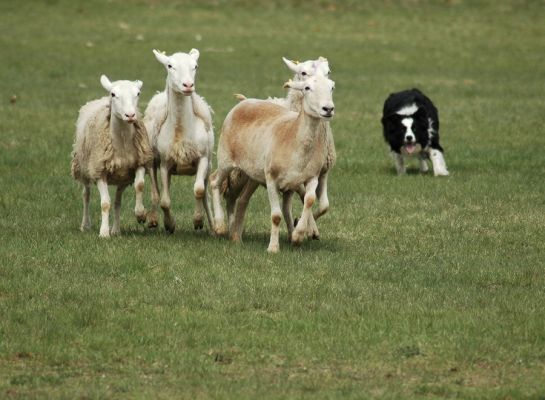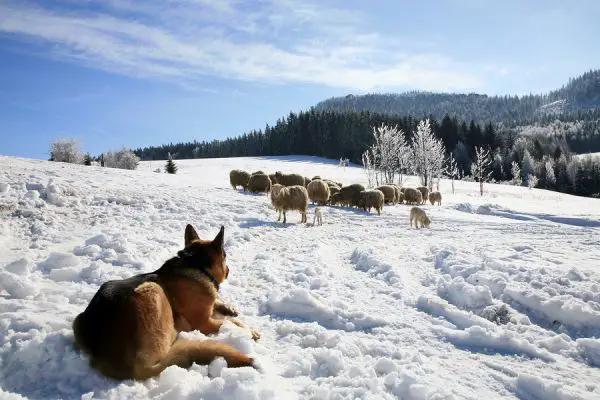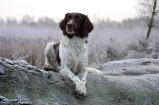
This is a placeholder text
Group text
An Introduction to Herding
Herding is one of oldest canine activities available. It has real world applications and is still in place for viable farm assistance in many places. For urban individuals, herding has become more of a training activity for competition for those breeds of dogs with natural instinct.
How Herding Works
 Herding is really based on a dog’s natural prey drive and hunting instinct. Imagine watching a wolf pack hunting. A group of wolves spots a group of caribou or moose; instinctually the wolves separate from one another and position themselves in such a way that they encircle a prey target. Their goal is to separate one of the animals from its herd, and if you watch closely, you will see several wolves go to the outer edges to form a circle around the herd and a wolf or two that will drive through the herd from the other side or rear. They will drive them towards the outer circle of wolves. What happens is an efficient methodology for the wolves because all the wolves are in a position to ensnare the selected animal.
Herding is really based on a dog’s natural prey drive and hunting instinct. Imagine watching a wolf pack hunting. A group of wolves spots a group of caribou or moose; instinctually the wolves separate from one another and position themselves in such a way that they encircle a prey target. Their goal is to separate one of the animals from its herd, and if you watch closely, you will see several wolves go to the outer edges to form a circle around the herd and a wolf or two that will drive through the herd from the other side or rear. They will drive them towards the outer circle of wolves. What happens is an efficient methodology for the wolves because all the wolves are in a position to ensnare the selected animal. This is essentially how herding works too only we are not looking for the full prey drive sequence. We want the dogs to circle the stock, move the stock, and sometimes even separate the stock, but we don’t want them to move towards harming or killing the stock. We serve as an extension of the dog pack as we are often located on the opposite side of the stock from the dog thereby keeping the stock between the dog and us.
In the real world application of herding, dogs have been bred to primarily move sheep or cattle, but the dogs could be used to move other animals as well. Additionally, some breeds have been developed to keep a hard eye on the stock (such as the border collie), have a more loose eye (such as the Puli), or a more naturally tending style (such as the German Shepherd Dog). There are also guardian herding breeds (such as the Great Pyrenees or Anatolian Shepherd), but these dogs don’t move flock; they simply provide protection from external predators like stray dogs, coyotes, and others.
Competition Herding
The principles of herding that would be used on the farm are the same ones in play for competition. You have the option as to what stock you choose to train your dog on and compete with. The commonly used animals are sheep, cattle, and ducks, although ducks are primarily a smaller dog event.Just as with other styles of competition, herding has various levels of complexity. The primary focus for most herding events is for the dog to:
- Locate a group of stock
- Move them towards the handler, not away from the handler, in a group
- Move the stock where the handler is directing including through obstacles like gates or into pens
- Separate some individuals from the herd if need be
In tending style courses, the dog’s job is more of working as a living fence. This would have been useful to move the sheep from one pasture to another as well as keep the sheep from going into areas that they weren’t allowed into. Trials ask the dog to perform a similar function. Though the German Shepherd Dog has traditionally been more a tending style dog, they can also be trained to gather flock and move them.
Competitions are used to determine not only how well a dog can move stock but also how well the handler can work with the dog. Dogs are only given a set amount of time to handle the course.
Training for Herding
The first important step in herding training for any dog is determining whether the dog has the natural instinct. These herding instinct tests are offered frequently as group events, but you can also locate an experienced, qualified instructor that can assist you one-on-one.In a herding instinct test, a flock of animals will be enclosed in a large open corral, field, or pen. The flock will be small, perhaps 5 animals. A dog will be allowed to enter the pen with the handler and evaluator. Some evaluators prefer having the dog on a long leash line or dragging a leash in case it gets out of control or too aggressive with the stock. Others allow the dog off leash and closely watch it.
Many dogs will not have encountered livestock prior to this evaluation and so the reactions will vary. Many times the dog will sniff the area, watch from a distance initially, or casually move with the handler. What is important is how much interest the dog shows in the stock when they move.
A dog with natural instinct should perk at movement, move closer to the stock, and give chase when he realizes he can move them. He may vocalize, attempt to single a sheep out, jump on an animal, or even be mouthy with them. These are all things that can be controlled with training, but the important part is whether the dog shows this interest.
Once you know you have a dog with potential for further training, it is important to partner up with a qualified and experienced herding instructor. Not only will they teach you what commands your dog needs to know, but additionally they will show you how a dog should move stock, how to read the stock animals themselves, and how to confidently move and work with the dog.
For the best training you need to be able to have regular access to stock animals so that the dog can properly learn how to move the animals and be controlled and not just excite each time he sees them. Many people ultimately purchase their own sheep!
Check with herding organizations in your local area for qualified instructors, trials, and regulations.
Contact information Disclaimer Privacy Statement Copyright Information Terms of Service Cookie policy ↑ Back to top




